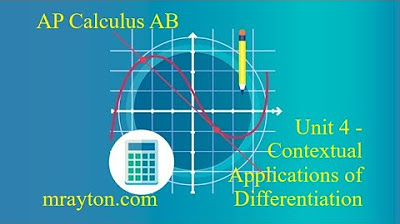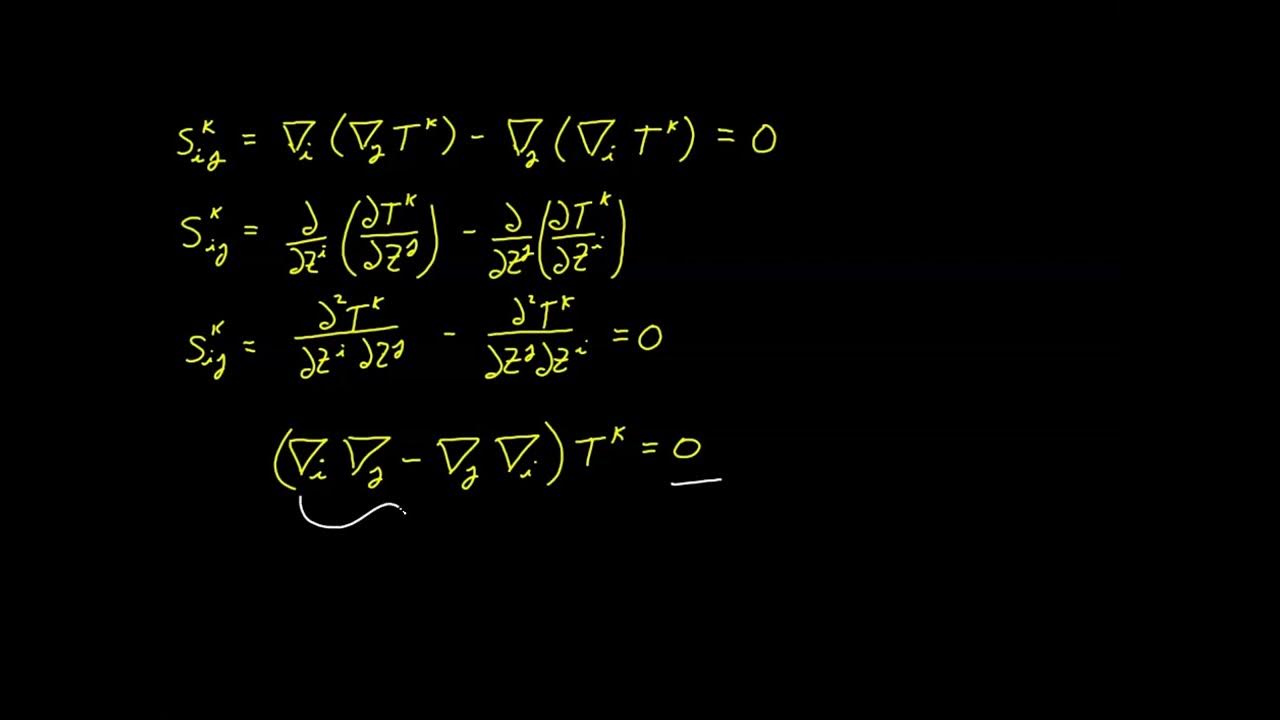Video 41 - Trajectories
TLDRThis video delves into tensor calculus to analyze the motion of a particle tracing a trajectory in space over time. It introduces the concepts of velocity and acceleration as time derivatives of the position vector, utilizing the chain rule and covariant derivatives. The intrinsic derivative, or absolute derivative, is defined for tensors of any rank, providing a syntax for representing changes along a curve parameterized by a scalar. The video also explores the application of these concepts to the trajectory analysis, including expressing velocity, acceleration, and jolt as linear combinations, offering a deeper understanding of motion in various coordinate systems.
Takeaways
- 📚 The video discusses tensor calculus and its application to analyzing the motion of a particle in space over time.
- 🚀 The position of a particle is represented as a vector function of time, and its trajectory is analyzed using the position vector and the chain rule.
- 🔍 Velocity is defined as the time derivative of the position vector, and it can be expanded using the chain rule and partial derivatives.
- 🌀 The velocity vector is expressed as a linear combination of basis vectors, with scalar factors that are tensors derived from the quotient theorem.
- 📉 The video introduces the concept of the intrinsic derivative, also known as the absolute or total derivative, which generalizes the process for tensors of any rank.
- 🔄 The intrinsic derivative is used to find how tensors change along a curve parameterized by a parameter Lambda, maintaining the same rank as the original tensor.
- 🛠 The acceleration of a particle is the time derivative of the velocity vector, and it can be represented using the intrinsic derivative.
- 🔧 The jolt, or surge, is defined as the time derivative of acceleration and follows a similar pattern to velocity and acceleration in its representation.
- 📐 The script explains how to expand the expressions for velocity, acceleration, and jolt into more usable forms for specific coordinate systems.
- 📝 The intrinsic derivative shares properties with the covariant derivative, such as sum and product rules, and is applicable to any coordinate system.
- 🔑 The video concludes by summarizing the consistent form for representing the velocity, acceleration, and jolt of a particle moving through space.
Q & A
What is the primary focus of the video script?
-The video script primarily focuses on analyzing the motion of a particle as it moves through space, using tensor calculus to define and understand concepts such as position, velocity, acceleration, and jolt.
What is a trajectory in the context of the video?
-In the context of the video, a trajectory is the path that a particle traces out as it moves through space over time.
How is the position of a particle represented in the video?
-The position of a particle is represented by a position vector \( \vec{r} \), which is a function of time and the coordinate system being used.
What is the definition of velocity in the script?
-Velocity is defined as the time derivative of the position vector, represented as \( \frac{d\vec{r}}{dt} \), and can be expanded using the chain rule due to the composite nature of the position vector.
How is the velocity vector related to the covariant basis vector?
-The velocity vector is a linear combination of the covariant basis vectors, with the scalar factors being the time derivatives of the coordinate functions \( \frac{dz_i}{dt} \).
What is the significance of the intrinsic derivative in the context of the video?
-The intrinsic derivative, also known as the absolute or total derivative, is a new operation defined with respect to a parameter that is used to define a curve in space. It generalizes the process for tensors of any rank and provides information about how tensors change along the curve.
How does the acceleration of a particle relate to its velocity?
-Acceleration is defined as the time derivative of the velocity vector. It can be represented as a linear combination similar to velocity, but with the scalar factors being the intrinsic derivatives of the velocity components with respect to time.
What is the jolt in the context of the video script?
-The jolt, sometimes called the surge, is defined as the time derivative of the acceleration vector, representing the rate of change of acceleration.
How does the script explain the relationship between the velocity vector and the unit tangent vector?
-The script explains that the velocity vector is tangent to the curve at each point, and its magnitude is equal to the derivative of arc length with respect to time, \( \frac{ds}{dt} \).
What are some properties of the intrinsic derivative mentioned in the script?
-Some properties of the intrinsic derivative mentioned in the script include that it does not increase the rank of the tensor it operates on, and it shares many properties with the covariant derivative, such as the sum rule, product rule, and metric compatibility.
How can the intrinsic derivative be applied to tensors of different ranks?
-The intrinsic derivative can be applied to tensors of any rank by adding the appropriate terms for each free index, similar to how terms are added in the covariant derivative, with the addition of a factor related to the tangent vector components.
Outlines
📚 Tensor Calculus: Analyzing Particle Motion
This paragraph introduces the topic of analyzing the motion of a particle through space over time using tensor calculus. The position vector of the particle is represented as a function of time and the coordinate system, leading to the use of the chain rule for analysis. The velocity of the particle is defined as the time derivative of the position vector, and the concept of a trajectory is discussed, setting the stage for further exploration of motion dynamics.
🔍 Deriving Velocity and Acceleration Vectors
The paragraph delves into the specifics of calculating the velocity and acceleration of a particle. It explains how velocity is derived using the chain rule and partial derivatives, resulting in a linear combination of scalar factors and basis vectors. The acceleration is then defined as the time derivative of velocity, with a similar approach used to express it in terms of covariant derivatives and the Christoffel symbols introduced in a previous video. The intrinsic derivative, or absolute derivative, is introduced as a new concept for analyzing changes along a curve parameterized by a scalar parameter.
🌀 Exploring the Intrinsic Derivative and its Properties
This section introduces and explains the intrinsic derivative, a tensor calculus operation applied to tensors of any rank with respect to a space-defining curve parameter. The intrinsic derivative is shown to be similar to the covariant derivative but does not increase the rank of the tensor it operates on. Properties such as the sum rule, product rule, and metric compatibility are discussed, highlighting the utility of the intrinsic derivative in analyzing tensor changes along a curve.
🚀 Applying Intrinsic Derivative to Particle Dynamics
The intrinsic derivative is applied to the context of particle motion, specifically to express the acceleration vector in a simplified form. The paragraph shows how the acceleration can be represented as a linear combination of its components, with each component being the intrinsic derivative of the velocity component with respect to time. The process of expanding the expression for practical use in different coordinate systems is also discussed.
🔧 Expanding and Simplifying Acceleration Expressions
This paragraph focuses on expanding the expression for acceleration into a more usable form, detailing the steps to simplify the intrinsic derivative of the velocity component. The process involves applying the chain rule and covariant derivative, leading to an expression that can be evaluated in various coordinate systems. The paragraph also touches on the concept of 'jolt' or 'surge' as the time derivative of acceleration, continuing the pattern of using intrinsic derivatives.
🔄 Recap and Future Application of Intrinsic Derivatives
The final paragraph provides a recap of the intrinsic derivative operation and its application to the analysis of particle motion. It summarizes the definitions of velocity, acceleration, and jolt in terms of intrinsic derivatives and their representation as linear combinations. The paragraph also previews the application of these concepts to specific coordinate systems in future videos, emphasizing the generality and usefulness of the intrinsic derivative in tensor calculus.
Mindmap
Keywords
💡Tensor Calculus
💡Trajectory
💡Position Vector
💡Velocity
💡Covariate Basis Vector
💡Acceleration
💡Covariant Derivative
💡Intrinsic Derivative
💡Jolt
💡Christoffel Symbols
💡Arc Length
Highlights
Introduction to analyzing the motion of a particle using tensor calculus, focusing on the trajectory as a function of time.
Representation of the position vector r as a function of time and coordinate system z, creating a composite function for analysis.
Velocity defined as the time derivative of the position vector, expanded using the chain rule.
Explanation of the covariant basis vector and its role in the expression for velocity.
The velocity vector is represented as a linear combination with contravariant vector components.
Acceleration is defined as the time derivative of velocity, also expanded using the chain rule.
Introduction of the covariant derivative in the context of acceleration.
The intrinsic derivative, or absolute derivative, is introduced as a new type of derivative operation.
Properties of the intrinsic derivative, including its effect on the rank of a tensor.
Application of the intrinsic derivative to scalar functions, relating it to the directional derivative.
Acceleration vector expressed using the intrinsic derivative, providing a simple syntax for its components.
Expansion of the acceleration expression into a more usable form for coordinate systems.
Introduction of the jolt, or surge, as the time derivative of acceleration.
Expression of jolt as a linear combination with contravariant vector components using intrinsic derivatives.
Recap of the intrinsic derivative's application in analyzing particle motion, including velocity, acceleration, and jolt.
Demonstration of how to expand the intrinsic derivative expressions for practical evaluation in various coordinate systems.
Transcripts
5.0 / 5 (0 votes)
Thanks for rating:





